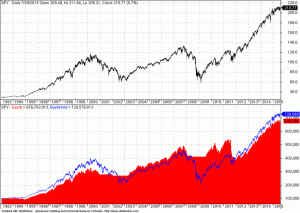Momentum is Price Breakout
by Mike Harris, Price Action Lab
Lately, there is a tendency to associate momentum, relative strength or cross-sectional, to quantitative analysis and label absolute momentum as technical analysis. Nothing can be further from the truth. Momentum is a trivial concept that is based on breakouts above a past price. At the same time, absolute momentum is much broader in scope than relative despite recent efforts to relate them.
In the last few years there is a massive production of academic papers on the subject of trading strategies. Possibly a declaration will be made soon that trading rules were discovered by university research. The situation has become a bit amusing. Those of us who trade for many years are surprised to see old concepts dressed up with new names and presented as academic research. Academics should know that almost everything that was to be discovered about trading was already discovered in the 1980s and 1990s, including technical indicators, backtesting, quant analysis, neural networks and machine learning.
Let us consider for example the price rate of change (ROC) used in relative strength momentum models:
ROC(n) = (C – Cn)/Cn (1)
Basically, this is the arithmetic return over n periods. Note that the denominator is always positive and therefore, ROC(n) changes sign when (C-Cn) changes sign. There is nothing new in this as it is known to traders for ages. The result is that the following two strategies are equivalent:
- Looking at sign changes of n-period returns, (C-Cn)/Cn
- Looking at a breakout of price C above or below the price n-periods ago, Cn
A backtest should convince a skeptic. Consider the following trading system
Trading System 1:
Buy when ROC(close, 200) > 0
Sell when ROC(close, 200) < 0
Basically, this system buys a security when the trailing 200-period return turns positive and sells it when it turns negative.
Also consider the following trading system:
Trading System 2:
Buy when (Close - Close of 200 days ago) > 0
Sell when (Close - Close of 200 days ago) < 0
We will use adjusted SPY data since inception to 07/29/2015, starting capital of $100,000, fully invested equity at the open of the day following the signal and $0.01 commission per share.
Below are the equity curves. They are identical, as expected (click to enlarge)
 |
 |
Note that the performance of both systems is below buy and hold during strong uptrends of 1990s and 2010s. The systems trade-off performance during strong uptrends for reduced risks during downtrends.
Next, it is also a fact known for ages that an indicator that uses the change in direction of a moving average with period n is equivalent to ROC(n) or (C-Cn), as described above. Consider the following system:
Trading System 3:
Buy when (MA(n) - MA(n) of one period ago) > 0
Sell when (MA(n) - MA(n) of one period ago) < 0
Trading system 3 generated identical results with the two systems considered before. This is because of the following equivalence
MA(n) – MA(n) of one period ago = (C – Cn)/n (2)
Actually, this is also a price breakout system with the rule divided by n, something that does not affect the sign changes.
The strawman argument
The trivial results in equations (1) and (2) were recently used in an academic paper to set up a strawman argument about the general structure of technical indicators. After many approximation and handwaving, the author of the paper abducted conclusions that are not related to performance of trading rules based on moving average crossovers, for example. The fact that all technical trading rules are related in some ways is known for ages. However, this is not the point. The point is that different rules lead to different performance. For example, let us consider the performance of the ROC(200) versus a long-only 50-200 moving average crossover system in SPY with same data and backtest parameters as before.
| Parameter | ROC(200) Trading System 1 |
50-200 crossover Long -only |
| CAR | 8.83% | 10.11% |
| Max. DD | -29.17% | -19.39% |
| Win rate | 41.30% | 80% |
| Sharpe | 0.32 | 0.56 |
| Trades | 46 | 10 |
It may be seen that the 50-200 crossover performance is superior but this comes at a severe reduction of sample size, from 46 to 10 trades. Trading rules with small trade samples may be curve-fitted. The main trade-off is between low and high win rate. As the win rate drops below 50%, trading systems become susceptible to large drawdown levels and possibly ruin. Therefore, this is something to keep in mind:
Small trade samples trade-off significance for performance
This is the “curse of trading system development.” As one attempts to increase performance in longer timeframes, samples decrease, leading to lower significance. This problem can be solved by utilizing ultra fast timeframes, with the requirements imposed, and making a transition from directional trading to market making (HFT). This is what some markets participants have done. Those who still trade longer timeframes face issues of significance with their systems.
Conclusion
I have shown in this blog that momentum is simply a price breakout and therefore a technical analysis rule, actually a trivial one. Therefore, any claims that momentum falls under quantitative trading and other rules, such as moving average crossovers, fall under technical analysis, is false. Then, I showed with an example that trading rules that employ moving average crossovers are much different than those employing momentum. The simple explanation for that is that moving averages smooth volatility and thus generate smaller trade samples, trading-off significance for performance.
Finally, there can be no generalizations about trading rules. Although at an abstract level all trading rules can be placed within a certain framework, it is performance that matters. Results in trading are judged by performance and whether rules are similar or different is not really important. Most everything about trading rules is already known since the 1980s and even before that. What is now important is how to conceive new rules that are not influenced much by data-snooping and not to re-classify trading rules by assigning to them new names and present them as accomplishments of academic research. Given the high rate of productions of academic papers, many of which deal with simple rules, it appears that we are not far from the point that some professor will declare that the concept of a trading rule was invented by academic research. Trading is an area where practice is always ahead of academic research.
Copyright © Price Action Lab















